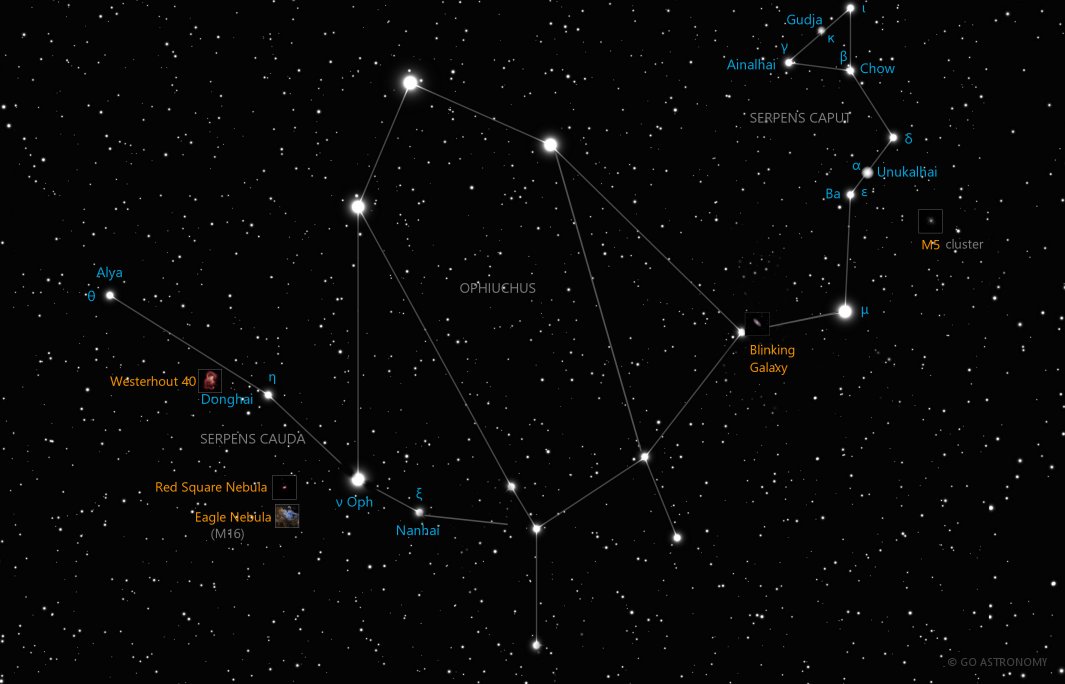Serpens, the Snake (Ser)
(SER-punz)
The Northern constellation of Serpens, the Snake, is best viewed in Summer during the month of July.
Serpens is the 23rd largest constellation. It's brightest star is Unukalhai at magnitude 2.63. The boundary of the Serpens constellation contains 14 stars that host known exoplanets.
Serpens is an equatorial constellation, which means its bulk intersects the celestial equator or comes within 10-15 degrees of doing so. Serpens is visible from most places on Earth.
- Pronunciation:
- SER-punz
- Meaning:
- Snake
- Genitive:
- Serpentis
- Abbreviation:
- Ser
- Constellation Family:
- Hercules
- Hemisphere:
- Northern
- Quadrant:
- NQ3
- Visibility:
- 80° N - 80° S
- Best viewing month*:
- July
- Area:
- 637 sq. degrees
- Size:
- 23rd largest
- Equatorial:
- Yes
- Right Ascension (avg):
- 18h
- Declination (avg):
- -13°
- Brightest star:
- Unukalhai (2.63)
- Stars with planets:
- 14
- Messier objects:
- |
- Caldwell objects:
- |
Brightest Stars in Serpens
The 10 brightest stars in the constellation Serpens by magnitude.
- Star
- Magnitude
- Spectral class
- Alpha Serpentis (α Ser)
- 2.63
- K2III
- Eta Serpentis (η Ser)
- 3.23
- K0III-IV
- Mu Serpentis (μ Ser)
- 3.54
- A0V
- Xi Serpentis (ξ Ser)
- 3.54
- F0IIIp
- Beta Serpentis (β Ser)
- 3.65
- A3V
- Epsilon Serpentis (ε Ser)
- 3.71
- A2m
- Gamma Serpentis (γ Ser)
- 5.2
- F6V
- Kappa Serpentis (κ Ser)
- 4.09
- M1III
- Delta Serpentis (δ Ser A)
- 3.8
- F0IV
- Omicron Serpentis (ο Ser)
- 4.24
- A2Va
Double Stars in Serpens
These are the brightest and easiest-to-find double, triple, and quadruple star systems in the constellation Serpens. Also see all star clusters.
- Star system
- Magnitudes
- Type
- Delta Serpentis
- 4.2, 5.2
- double
- Theta Serpentis
- 4.6, 4.9
- double
Star Clusters in Serpens
The most notable and easy-to-find star clusters in the constellation Serpens . Also see all star clusters.
Nebulae in Serpens
Notable and easy-to-find nebulae in the constellation Serpens. Also see all nebulae.
Galaxies in Serpens
The most notable galaxies in the constellation Serpens. Also see all galaxies.
- Name
- Alt name
- Type
- Hoag?s Object
- ring
- Seyfert's Sextet
- galaxy group
- Arp 220
- galaxy
- Death Star Galaxy
- galaxy pair
Neutron Stars in Serpens
These are the most well-known neutron stars in the constellation Serpens. Although neutron stars cannot be seen in any amateur telescope, they are at the center of many supernova remnant nebulae, which can be seen. Also see all neutron stars.
The Serpent in the Sky
As one of the 48 constellations listed by the 2nd-century Greek astronomer Ptolemy and one of the 88 modern constellations recognized by the International Astronomical Union (IAU), Serpens holds a unique position in the celestial sphere.
Historical Background
Serpens, Latin for "the serpent", is one of the few constellations that depict a non-mythical animal. The constellation is represented as a snake held by the healer Asclepius, represented by the neighboring constellation Ophiuchus. This celestial depiction is rooted in ancient Greek mythology, where Asclepius, the god of medicine, was said to have learned the secrets of keeping death at bay after observing one serpent bringing healing herbs to another.
Distinctive Characteristics
Serpens is unique in that it's the only constellation divided into two non-contiguous parts: Serpens Caput (the Serpent's Head) to the west and Serpens Cauda (the Serpent's Tail) to the east. Ophiuchus, the "Serpent-Bearer" constellation, sits in the middle, creating this distinctive split. The constellation's brightest star, Unukalhai (Alpha Serpentis), is located in Serpens Caput and is easily recognizable for its slightly orange hue.
Celestial Objects of Interest
Despite its split form, Serpens contains a wealth of deep-sky objects that are of interest to astronomers and astrophotographers alike. Most notably, it houses the Eagle Nebula (Messier 16), which contains the famous astronomical feature known as the "Pillars of Creation" ? a star-forming region beautifully captured by the Hubble Space Telescope. This is a region where new stars are being born, and it provides a stunning look at the life-giving processes of the universe.
Additionally, the constellation also contains the globular cluster M5, one of the oldest known globular clusters in the Milky Way galaxy. At an estimated age of 13 billion years, this dense cluster of stars provides a view back to the early cosmos, making it a fascinating object for observation and study.
Observation
Given its position on the celestial equator, Serpens is visible from every location on Earth, except for near the polar regions. The best time for observing this constellation is in the late spring and early summer, particularly in June when it reaches its highest point in the sky.
Observing the constellation and its deep-sky objects requires a clear night and a dark sky, free from light pollution. While the constellation's stars can be seen with the naked eye in good conditions, a small to medium-sized telescope will allow viewers to observe its deep-sky objects in more detail.
Conclusion
Serpens is a constellation that offers something for every stargazer, from its unique two-part shape to its rich collection of deep-sky objects. Whether observing the Eagle Nebula's star-forming regions, gazing at ancient globular cluster M5, or simply tracing the serpent's form in the night sky, exploring Serpens offers a captivating journey through the cosmos.
* Constellation shown for northen hemisphere skies. For the southern hemisphere, constellations appear rotated 180 degrees (upside-down and left-right reversed) from what is shown. Remember that seasons are reversed too - summer in northern latitudes is winter in southern latitudes.
** Circumpolar constellations are visible year-round in the hemisphere listed (and not at all in the opposite hemisphere).





